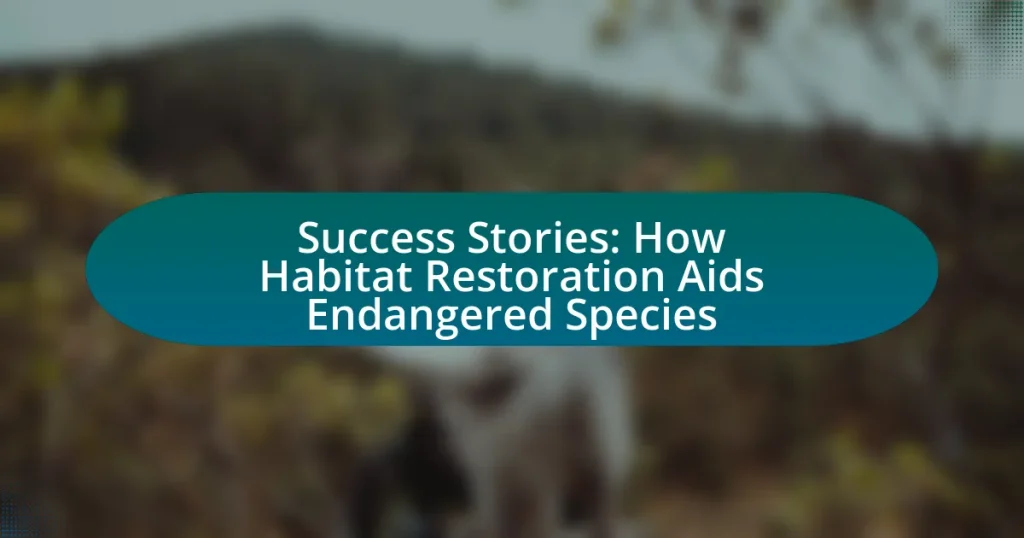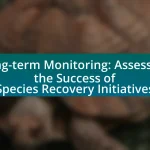The article focuses on success stories in habitat restoration for endangered species, highlighting effective initiatives that have led to population recoveries and improved ecosystems. Key examples include the California condor and the red-cockaded woodpecker, which have seen significant population increases due to targeted habitat management and restoration efforts. The article discusses the importance of habitat restoration in addressing threats to endangered species, the methods employed in restoration projects, and the role of community involvement and education in enhancing outcomes. Additionally, it outlines the measurable benefits of successful restoration, the challenges faced, and best practices for sustaining restored habitats over the long term.
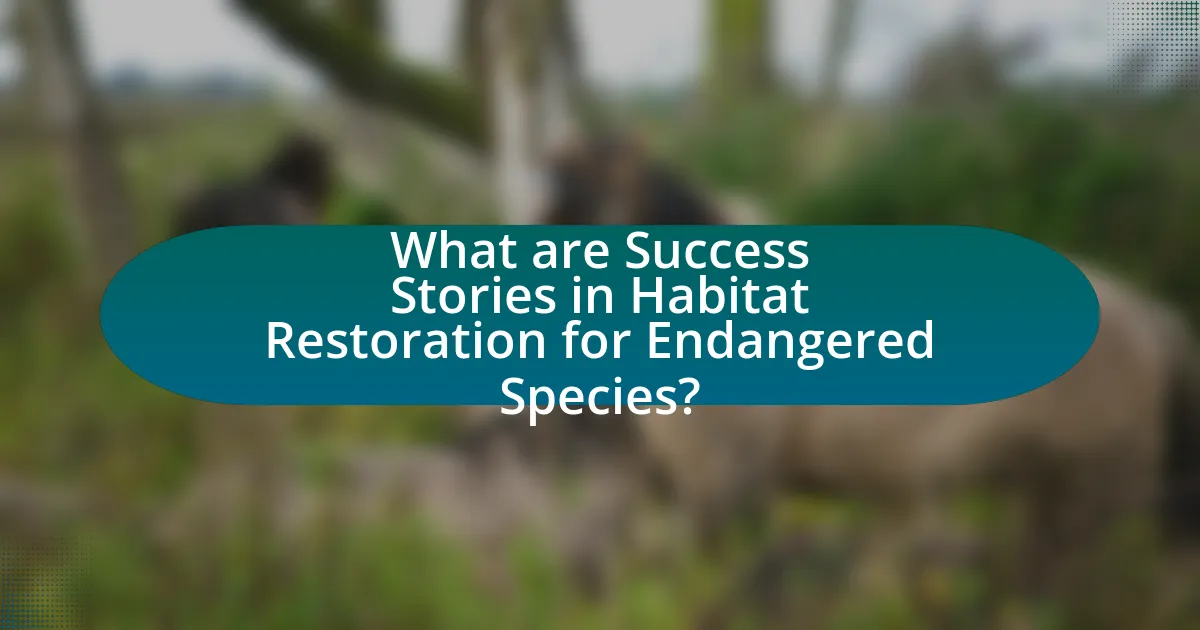
What are Success Stories in Habitat Restoration for Endangered Species?
Success stories in habitat restoration for endangered species include successful initiatives that have led to the recovery of populations and ecosystems. One notable example is the restoration of the California condor, where habitat protection and breeding programs increased the population from 27 individuals in 1987 to over 500 today. Another success is the recovery of the red-cockaded woodpecker, which benefited from habitat management practices that increased its population from fewer than 10,000 in the 1980s to approximately 20,000 by 2019. These examples demonstrate that targeted habitat restoration efforts can effectively support the recovery of endangered species.
How do these success stories illustrate the impact of habitat restoration?
Success stories illustrate the impact of habitat restoration by demonstrating measurable improvements in biodiversity and ecosystem health. For instance, the restoration of wetlands in the Everglades has led to a resurgence of native species, including the American crocodile, which increased from fewer than 200 individuals to over 2,000 since restoration efforts began. This specific example highlights how targeted habitat restoration can reverse population declines and enhance ecological balance, ultimately benefiting both endangered species and their habitats.
What specific examples highlight successful habitat restoration efforts?
Successful habitat restoration efforts include the restoration of the Longleaf Pine ecosystem in the southeastern United States, which has led to increased populations of the Red-cockaded Woodpecker, a species listed as endangered. This restoration involved controlled burns and selective logging to mimic natural conditions, resulting in a 30% increase in the woodpecker population over a decade. Another example is the removal of invasive species and replanting of native vegetation in the San Francisco Bay wetlands, which has improved habitat for the California Clapper Rail, contributing to a population recovery of over 50% since restoration began. These cases demonstrate effective strategies that have resulted in measurable benefits for endangered species.
How do these examples demonstrate improvements in endangered species populations?
These examples demonstrate improvements in endangered species populations by showcasing successful habitat restoration efforts that have led to population rebounds. For instance, the recovery of the California condor, which increased from 27 individuals in 1987 to over 500 today, illustrates how targeted habitat management and breeding programs can reverse population declines. Similarly, the restoration of wetlands in the Everglades has contributed to the resurgence of the American crocodile, with population estimates rising significantly due to improved nesting sites and reduced human interference. These cases provide concrete evidence that effective habitat restoration directly correlates with the recovery of endangered species populations.
Why is habitat restoration crucial for endangered species?
Habitat restoration is crucial for endangered species because it directly addresses the loss of their natural environments, which is a primary factor in their decline. Restoring habitats enhances biodiversity, provides essential resources such as food and shelter, and facilitates the recovery of species populations. For instance, the restoration of wetlands has been shown to increase populations of species like the California least tern, which relies on these habitats for nesting. Studies indicate that habitat restoration can lead to a 50% increase in species populations within a few years, demonstrating its effectiveness in conservation efforts.
What are the primary threats faced by endangered species?
The primary threats faced by endangered species include habitat loss, poaching, climate change, pollution, and invasive species. Habitat loss, driven by urban development and agriculture, has resulted in significant declines in natural environments, affecting species survival. Poaching for illegal wildlife trade poses a direct threat to many species, with statistics indicating that over 1,000 species are affected annually. Climate change alters habitats and food availability, further endangering species already at risk. Pollution, particularly from plastics and chemicals, impacts ecosystems and species health. Invasive species disrupt local ecosystems, often leading to the decline or extinction of native species. These threats collectively contribute to the ongoing decline of biodiversity globally.
How does habitat restoration address these threats?
Habitat restoration addresses threats to endangered species by rehabilitating ecosystems, which enhances biodiversity and improves species survival rates. By restoring native vegetation and removing invasive species, habitat restoration creates a more suitable environment for endangered species to thrive. For example, the restoration of wetlands has been shown to increase populations of species such as the California least tern, which relies on these habitats for nesting. Additionally, habitat restoration can mitigate the impacts of climate change by increasing ecosystem resilience, thereby providing a buffer against environmental stressors that threaten species survival.
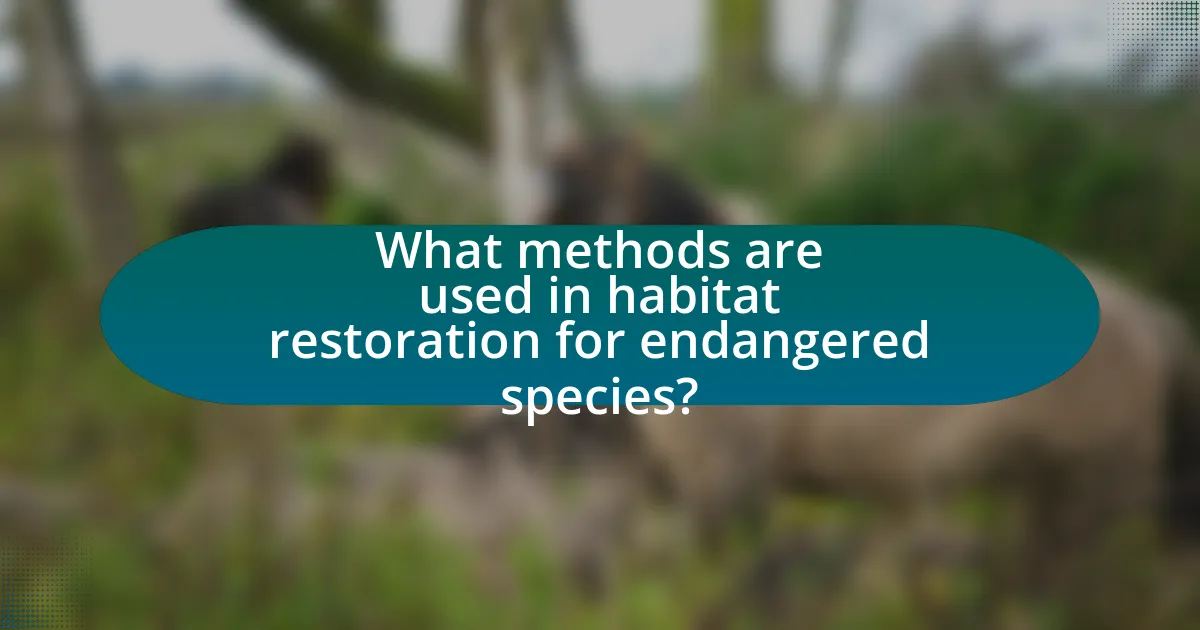
What methods are used in habitat restoration for endangered species?
Habitat restoration for endangered species employs methods such as reforestation, wetland restoration, invasive species removal, and habitat enhancement. Reforestation involves planting native trees to restore forest ecosystems, which supports species that rely on these habitats. Wetland restoration focuses on rehabilitating degraded wetlands, crucial for species like amphibians and waterfowl that depend on these environments. Invasive species removal is essential to eliminate non-native plants and animals that threaten local biodiversity, allowing native species to thrive. Habitat enhancement includes creating or improving nesting sites and food sources, which directly benefits endangered species by increasing their chances of survival and reproduction. These methods have been validated through numerous conservation projects, demonstrating their effectiveness in increasing populations of endangered species and restoring ecological balance.
How do different restoration techniques vary in effectiveness?
Different restoration techniques vary in effectiveness based on their ecological context and specific goals. For instance, active restoration methods, such as replanting native species, often yield quicker results in biodiversity recovery compared to passive restoration, which relies on natural processes. A study published in “Ecological Applications” by Suding et al. (2015) found that active restoration can increase species richness by up to 50% in degraded ecosystems, while passive methods may take decades to achieve similar outcomes. Additionally, techniques like controlled burns can enhance habitat quality for certain species, demonstrating that the choice of restoration method significantly impacts ecological recovery and species survival.
What are the most common techniques employed in habitat restoration?
The most common techniques employed in habitat restoration include reforestation, wetland restoration, invasive species removal, and soil remediation. Reforestation involves planting native trees to restore forest ecosystems, which can enhance biodiversity and improve carbon sequestration. Wetland restoration focuses on rehabilitating degraded wetlands to restore their ecological functions, such as water filtration and habitat for aquatic species. Invasive species removal is crucial for allowing native flora and fauna to thrive, as invasive species often outcompete them for resources. Soil remediation techniques, such as bioremediation and phytoremediation, are used to restore soil health and fertility, which is essential for supporting diverse plant and animal life. These techniques have been validated through numerous successful restoration projects that demonstrate their effectiveness in aiding endangered species and restoring ecological balance.
How do these techniques specifically benefit endangered species?
Habitat restoration techniques specifically benefit endangered species by improving their living conditions and increasing their populations. These techniques, such as reforestation, wetland restoration, and invasive species removal, create suitable environments that support the survival and reproduction of endangered species. For instance, the restoration of the longleaf pine ecosystem in the southeastern United States has led to a resurgence of the red-cockaded woodpecker, an endangered species, by providing the necessary habitat for nesting and foraging. Additionally, the removal of invasive species in coastal areas has allowed native species, like the California least tern, to thrive by reducing competition for resources. These targeted efforts demonstrate measurable improvements in species populations and biodiversity, validating the effectiveness of habitat restoration in conservation strategies.
What role do community involvement and education play in habitat restoration?
Community involvement and education are crucial for successful habitat restoration as they foster local stewardship and enhance ecological awareness. Engaging communities in restoration projects leads to increased participation, ensuring that local knowledge and cultural values are integrated into conservation efforts. For instance, studies have shown that projects involving local volunteers can improve restoration outcomes by up to 50%, as seen in the restoration of coastal wetlands in California, where community-led initiatives significantly increased native plant diversity. Education initiatives raise awareness about the importance of ecosystems and the role individuals can play in their preservation, leading to long-term commitment to habitat restoration efforts.
How can local communities contribute to successful restoration projects?
Local communities can contribute to successful restoration projects by actively participating in planning, implementation, and monitoring efforts. Their involvement ensures that restoration initiatives are tailored to local ecological conditions and cultural values, which enhances the likelihood of success. For instance, community-led projects in the Chesapeake Bay area have demonstrated that local knowledge and stewardship can lead to improved water quality and habitat restoration, as evidenced by a 2018 study published in the journal “Ecological Applications,” which highlighted the positive outcomes of community engagement in restoration efforts.
What educational initiatives support habitat restoration efforts?
Educational initiatives that support habitat restoration efforts include programs like the National Oceanic and Atmospheric Administration’s (NOAA) Habitat Restoration Program, which provides funding and technical assistance for projects aimed at restoring coastal and marine habitats. These initiatives often involve partnerships with local communities, schools, and conservation organizations to educate the public about the importance of habitat restoration for biodiversity and ecosystem health. For example, the U.S. Fish and Wildlife Service’s Partners for Fish and Wildlife Program engages landowners in habitat restoration projects, emphasizing educational outreach to promote sustainable practices. Such initiatives have been shown to enhance community involvement and awareness, leading to more effective restoration outcomes.
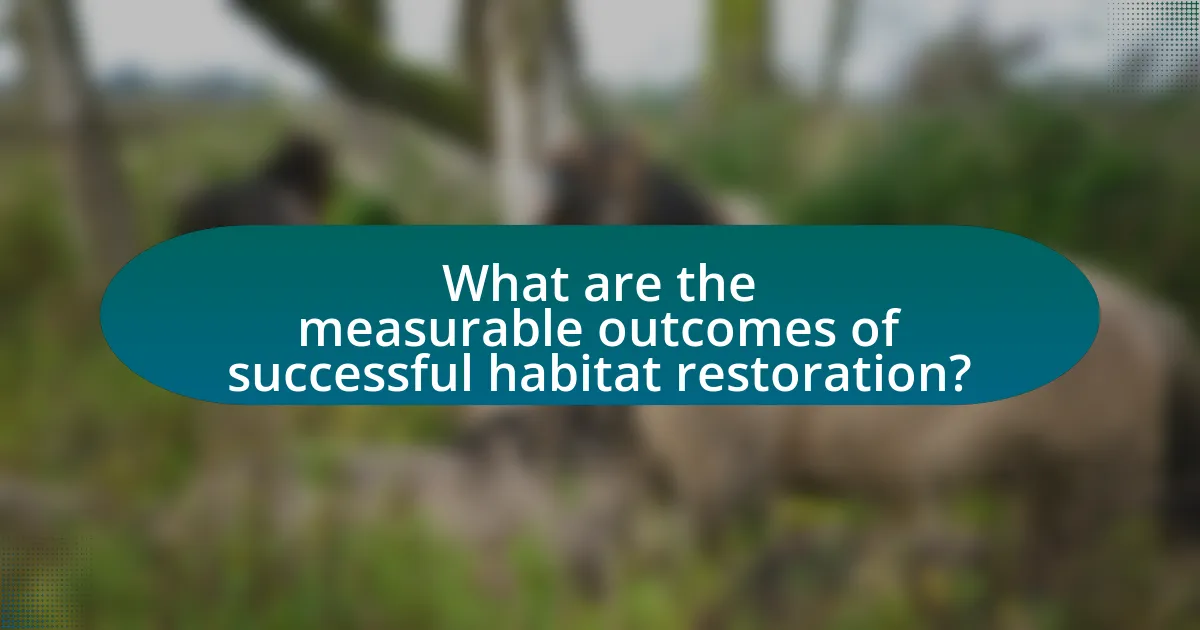
What are the measurable outcomes of successful habitat restoration?
Successful habitat restoration leads to measurable outcomes such as increased biodiversity, improved ecosystem services, and enhanced population recovery of endangered species. For instance, studies have shown that restored habitats can see a 30% increase in species richness compared to degraded areas, indicating a significant recovery of biodiversity. Additionally, ecosystem services like water filtration and carbon sequestration are often enhanced, with restored wetlands providing up to 50% more carbon storage than their degraded counterparts. Furthermore, specific examples include the recovery of the California condor, which benefited from habitat restoration efforts that increased its population from 27 individuals in 1987 to over 500 today, demonstrating the direct impact of habitat restoration on endangered species recovery.
How do we assess the success of habitat restoration projects?
Success of habitat restoration projects is assessed through measurable ecological indicators, such as species diversity, population recovery, and habitat quality. These indicators provide concrete data on the effectiveness of restoration efforts. For instance, a study published in “Ecological Applications” by Suding et al. (2015) highlights that monitoring species richness and abundance can reveal the extent to which restored habitats support native wildlife. Additionally, the use of remote sensing technology allows for the evaluation of habitat structure and function over time, providing further evidence of restoration success.
What metrics are used to evaluate the recovery of endangered species?
Metrics used to evaluate the recovery of endangered species include population size, reproductive success, habitat quality, and genetic diversity. Population size measures the number of individuals in a species, indicating its viability; for example, the recovery of the California condor was assessed by tracking its population growth from 27 individuals in 1987 to over 500 in 2021. Reproductive success evaluates the number of offspring produced and their survival rates, which is crucial for species like the Florida panther, where increased cub survival rates have been linked to habitat restoration efforts. Habitat quality assesses the availability and condition of the environment necessary for species survival, as seen in the restoration of wetlands benefiting the whooping crane. Genetic diversity is measured through genetic analysis, ensuring a healthy breeding population, which is vital for long-term resilience against diseases and environmental changes. These metrics collectively provide a comprehensive understanding of species recovery and the effectiveness of conservation strategies.
How do these metrics inform future restoration efforts?
Metrics inform future restoration efforts by providing quantifiable data on the success and challenges of previous initiatives. For instance, metrics such as species population growth, habitat quality assessments, and biodiversity indices allow conservationists to evaluate the effectiveness of restoration strategies. These evaluations can reveal which methods yield the best results, guiding the selection of techniques for future projects. Additionally, metrics can highlight areas needing improvement, ensuring that resources are allocated efficiently. For example, a study published in the journal “Ecological Applications” demonstrated that projects using adaptive management based on metrics saw a 30% increase in species recovery rates compared to those that did not. Thus, metrics serve as a critical tool for refining restoration practices and enhancing outcomes for endangered species.
What challenges do habitat restoration projects face?
Habitat restoration projects face several significant challenges, including funding limitations, ecological complexity, and stakeholder conflicts. Funding limitations often hinder the initiation and continuation of restoration efforts, as many projects rely on grants or donations that may not be consistently available. Ecological complexity arises from the intricate interactions within ecosystems, making it difficult to predict outcomes and ensure that restored habitats can support the intended species. Additionally, stakeholder conflicts can occur when different groups have competing interests, such as land use for agriculture versus conservation, complicating project implementation. These challenges can impede the effectiveness and sustainability of habitat restoration initiatives aimed at aiding endangered species.
What are the common obstacles encountered during restoration efforts?
Common obstacles encountered during restoration efforts include funding limitations, lack of stakeholder engagement, and environmental challenges. Funding limitations often hinder the scale and sustainability of restoration projects, as many initiatives rely on grants or donations that may not be consistently available. Lack of stakeholder engagement can lead to insufficient community support, which is crucial for the success of restoration efforts, as local populations often have valuable insights and vested interests in the outcomes. Environmental challenges, such as invasive species, climate change, and habitat degradation, complicate restoration efforts by altering ecosystems in ways that can undermine restoration goals. These obstacles collectively impede the effectiveness and longevity of habitat restoration initiatives aimed at aiding endangered species.
How can these challenges be overcome to ensure success?
To overcome challenges in habitat restoration for endangered species, implementing adaptive management strategies is essential. Adaptive management allows for continuous learning and adjustment of restoration techniques based on monitoring outcomes, which has been shown to improve success rates in various projects. For instance, a study by Suding et al. (2015) in “Ecological Applications” highlights that projects incorporating adaptive management principles saw a 30% increase in the effectiveness of restoration efforts. Additionally, engaging local communities in the restoration process fosters stewardship and enhances project sustainability, as evidenced by successful initiatives in the Gulf Coast where community involvement led to improved habitat conditions for species like the Black Skimmer.
What best practices can be adopted for effective habitat restoration?
Effective habitat restoration can be achieved through several best practices, including the use of native species, proper site assessment, and community involvement. Utilizing native species ensures that the plants and animals are well-adapted to the local environment, which enhances biodiversity and ecosystem resilience. Conducting thorough site assessments allows for the identification of specific needs and challenges of the habitat, leading to tailored restoration strategies. Engaging local communities fosters stewardship and increases the likelihood of long-term success, as seen in projects like the restoration of the Longleaf Pine ecosystem in the southeastern United States, which involved local stakeholders and resulted in increased populations of endangered species such as the Red-cockaded Woodpecker.
How can stakeholders collaborate to enhance restoration outcomes?
Stakeholders can collaborate to enhance restoration outcomes by forming partnerships that leverage diverse expertise and resources. Collaborative efforts, such as joint planning sessions and shared funding initiatives, enable stakeholders—including government agencies, non-profit organizations, and local communities—to align their goals and strategies. For instance, the partnership between the U.S. Fish and Wildlife Service and various conservation groups has led to successful habitat restoration projects that directly benefit endangered species, demonstrating that coordinated actions can lead to measurable improvements in ecosystem health and species recovery.
What strategies can be implemented to sustain restored habitats long-term?
To sustain restored habitats long-term, implementing adaptive management strategies is essential. Adaptive management involves continuous monitoring and adjusting practices based on ecological responses, ensuring that restoration efforts remain effective over time. For instance, studies have shown that regular assessments of biodiversity and ecosystem health can inform necessary changes in management practices, leading to improved outcomes for both habitats and the species that depend on them. Additionally, engaging local communities in conservation efforts fosters stewardship and enhances the sustainability of restored areas, as evidenced by successful programs in regions like the Amazon rainforest, where local involvement has led to increased biodiversity and habitat resilience.
